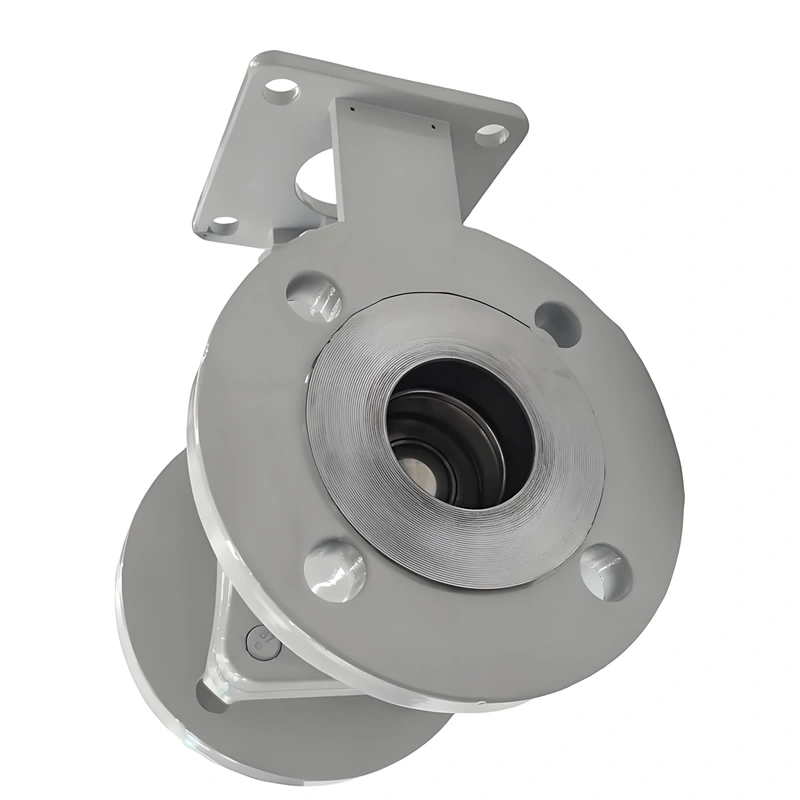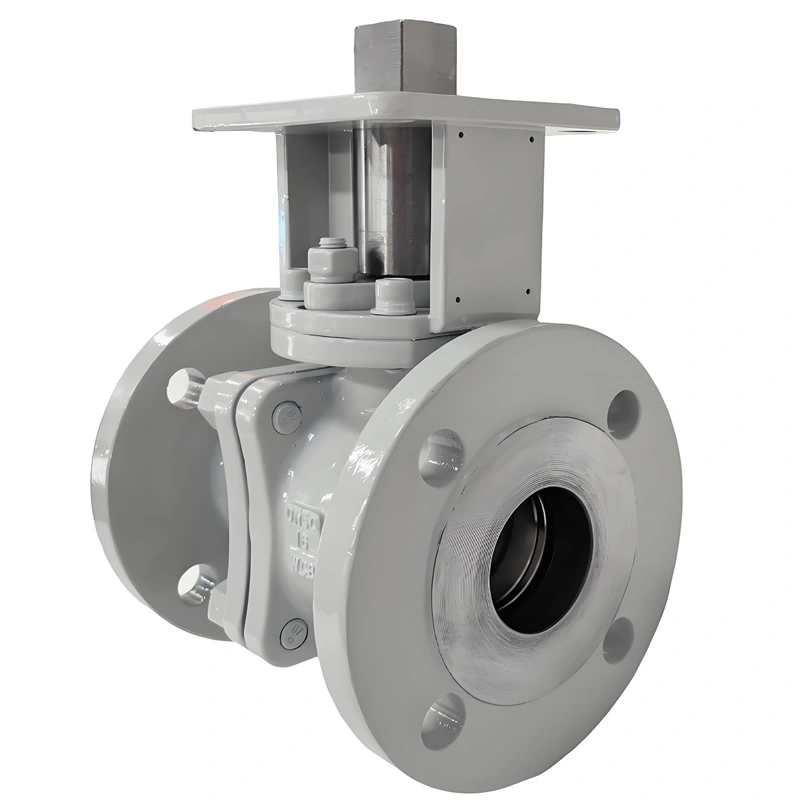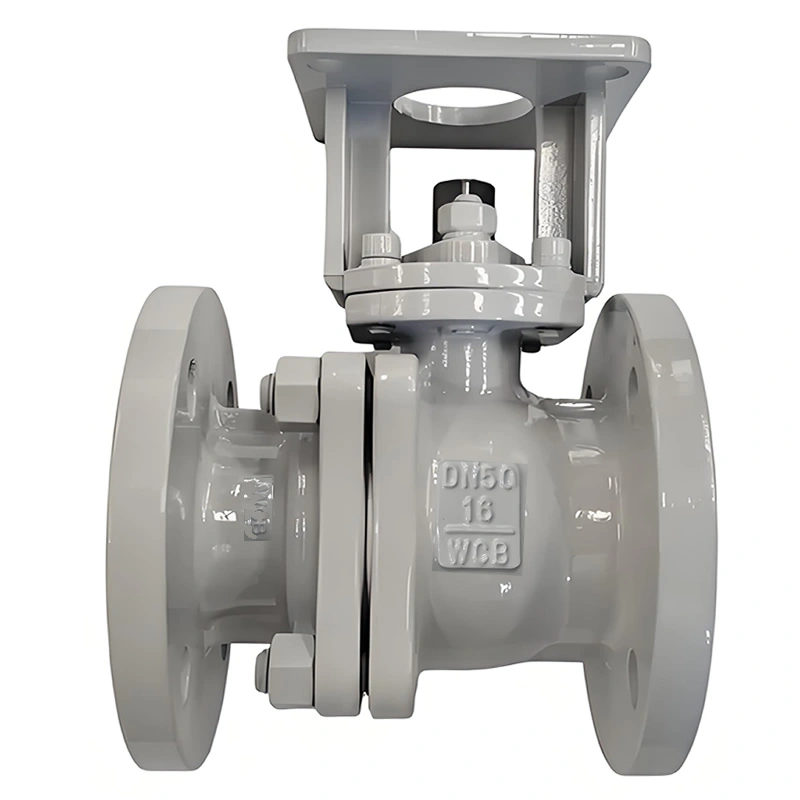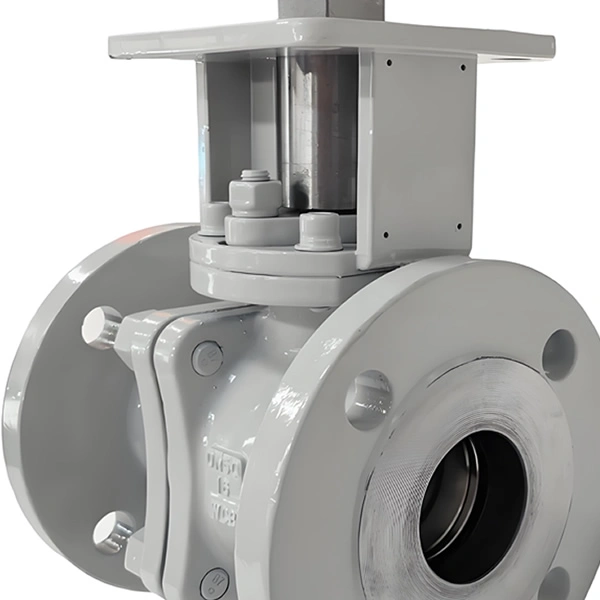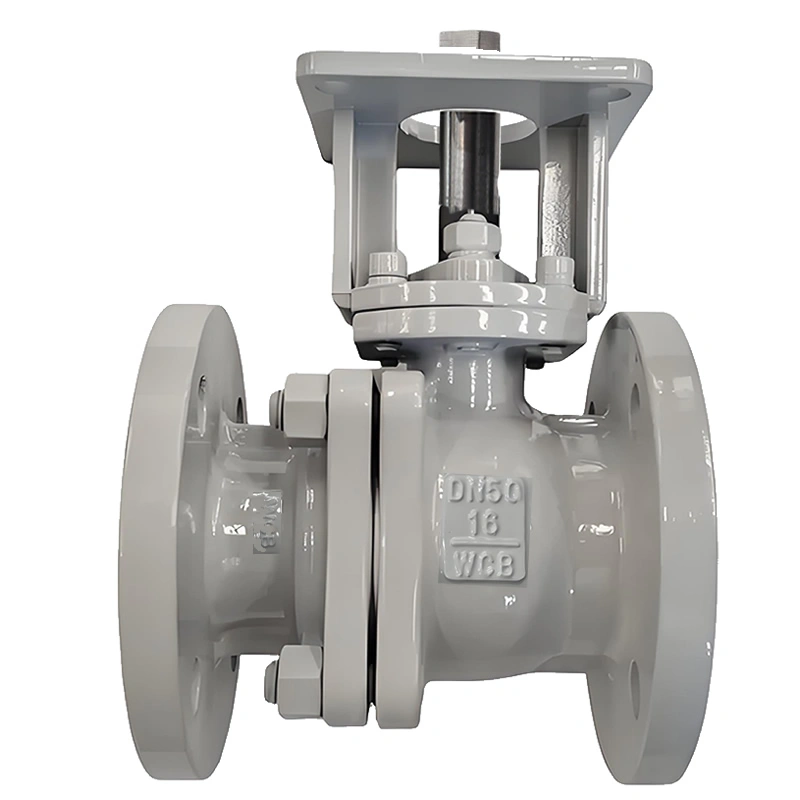- DN15 ~ DN800
- Class 150 ~ 600
- API 6D, ISO 17292
- Cast ASTM A216 WCB
- RF Flange (ASME B16.5)
- Two-Piece, Full Bore, Floating Ball
- PTFE (Std) / Metal (Optional)
- -29℃ ~ 180℃ (PTFE) / 425℃ (Metal)
- API 598 Class VI
- 1.5×PN (Shell), 1.1×PN (Seat)
- Manual Lever / Gear / Pneumatic / Electric
Specification
2PC PN16 DN50 Full Bore Flanged WCB Cast Steel Floating Ball Valve with Manual/Pneumatic/Electric Operation for Water, Oil & Gas Industrial Systems
I. Product Overview
Newway’s 2PC PN16 DN50 full bore flanged WCB cast steel floating ball valve is an industrial valve engineered for controlling non-corrosive media. Featuring a two-piece (2PC) construction and floating ball design, it is primarily made of WCB cast steel, with a full bore flow path and flanged connection. Compatible with manual, pneumatic, and electric operation modes, it is widely used in conveying and regulating water, oil, gas, and other media. Leveraging Newway’s years of technical expertise in industrial valves and strict quality control systems, this valve maintains stable opening/closing performance and sealing efficiency under high-pressure, normal-temperature conditions, providing reliable fluid control solutions for various industrial pipeline systems.
|
Product Name |
2PC PN16 DN50 Full Bore Flanged WCB Floating Ball Valve |
|
1. Material |
WCB(Stainless Steel/Duplex steel/Aluminium Bronze/Nickel-aluminum Bronze/Titanium Alloy, etc. available) |
|
2. Size |
1/2~40 inch ( DN15~DN800) |
|
3. Port |
Full Port |
|
4. Working Pressure |
PN16-PN100 / CLASS 150-600 |
|
5. Connection Ends |
RF |
|
6. Working Temp. |
-20ºC~200ºC |
|
7. Suitable Medium |
Non corrosive medium (water,oil,gas) |
|
8. Operated |
Manual, Worm Gear, Pneumatic actuator, Electric Actuator |
|
10. Manual option |
Locking Manual |
|
11. Design standard |
API6D/API608/API607,ASME B16.34,DIN,EN,JIS |
|
12. Inspection & Testing |
According to API598 |
|
13.Certificates |
ISO 9001, CE, TS, API6D,API607,AIP 6FA |
|
14.MOQ |
10 PCS/size(Special material depends on) |
|
|
|
II. Core Specifications and Parameters
1. Size and Pressure Rating
Nominal size: DN50 as a typical specification, covering DN15 to DN800 (1/2 inch to 40 inches), suitable for adapting to small-to-medium and large industrial pipelines;
Nominal pressure: Designed with a pressure rating of PN16, ranging from PN16 to PN100 (equivalent to CLASS 150 to CLASS 600), compatible with low-to-medium and medium-to-high pressure industrial systems. PN16 is particularly suitable for pressure requirements in conventional industrial pipelines and municipal engineering;
Connection type: Flanged connection (RF sealing face) is adopted, with flange dimensions and tolerances conforming to international standards, ensuring precise alignment with pipeline systems for easy and reliable installation.
2. Material Composition
Valve body material: The main body is made of WCB cast steel (carbon steel), featuring high strength (tensile strength ≥485MPa), good toughness, and wear resistance, capable of withstanding long-term erosion by non-corrosive media. It also offers options such as stainless steel (e.g., 304, 316), duplex steel, aluminum bronze, nickel-aluminum bronze, and titanium alloy to meet corrosion resistance requirements of different working conditions;
Valve seat material: Options include metal seals, PTFE (polytetrafluoroethylene), PTFE + carbon fiber, and PTFE + glass fiber, depending on media characteristics. PTFE series are suitable for normal-temperature, low-pressure scenarios, while metal seals are adapted to high-temperature, high-pressure environments;
Ball material: A solid floating ball design is used, matching the valve body material (e.g., WCB cast steel ball). The surface undergoes precision grinding to ensure tight fit with the valve seat, enhancing sealing efficiency.
3. Structure and Operation
Structure type: Two-piece split structure, with the valve body consisting of two parts connected by bolts, facilitating maintenance and replacement of internal components. The floating ball design allows the ball to automatically press against the valve seat under media pressure, achieving “pressure self-sealing.” The leakage rate in the closed state can reach Grade VI (zero leakage) as per GB/T 13927 standards;
Flow path type: Full bore design, with the flow path diameter consistent with the pipeline inner diameter, minimizing media flow resistance (flow resistance coefficient ≤0.1) and reducing pressure loss, especially suitable for scenarios requiring large flow conveying;
Operation mode: Supports multiple drive methods, including manual (with locking function), worm gear transmission, pneumatic actuators, and electric actuators. Manual operation is equipped with a lockable handle to prevent unauthorized misoperation; pneumatic/electric operation is suitable for systems requiring remote control or automatic adjustment;
Safety design: Integrates fire-resistant structure (compliant with API 607/6FA standards), maintaining basic sealing performance even after accidental fires. It also includes a built-in anti-static device, which conducts electricity between the ball and valve body via a conductive spring to prevent safety hazards caused by static accumulation.
4. Standards and Certifications
Design standards: Complies with international specifications such as API 6D, API 608, API 607, ASME B16.34, DIN, EN, and JIS, ensuring structural strength and performance stability;
Testing standards: Factory inspection is conducted in accordance with API 598 standards, including shell pressure test (1.5 times nominal pressure), sealing test (1.1 times nominal pressure), and operational flexibility test;
Certification qualifications: Certified by ISO 9001 quality management system, CE, TS, API 6D, API 607, and API 6FA, meeting access requirements of major global industrial markets.
Product Overview
III. Product Performance Features
1. Efficient Fluid Conveying Capacity
The full bore flow path is one of the core advantages of this valve. Compared to reduced-bore valves, its flow path diameter matches the pipeline, eliminating obvious “bottlenecks” during media flow and reducing local resistance loss by over 90%. For the DN50 specification, under the same media flow rate, its pressure loss is only 1/5 of that of reduced-bore valves, significantly reducing energy consumption of pump equipment. It is particularly suitable for long-distance transportation of oil and natural gas or large-flow water circulation systems (e.g., cooling water pipelines in thermal power plants).
2. Reliable Sealing and Pressure-Bearing Performance
The combination of the floating ball design and diverse valve seat materials endows the valve with excellent sealing reliability. When the valve is closed, media pressure pushes the ball toward the outlet-side valve seat, forming a tight fit—the higher the pressure, the more significant the sealing effect. Even under the rated PN16 pressure, it can achieve “zero leakage.” The wall thickness design of the WCB cast steel valve body complies with ASME B16.34 standards, withstanding 1.5 times the nominal pressure (24bar for PN16) in shell tests without deformation or leakage, ensuring structural safety under high-pressure conditions.
3. Flexible Operational Adaptability
Diverse operation modes enable adaptation to different scenarios: Manual operation (with locking) is suitable for small pipelines or systems requiring infrequent adjustment, with an operating force ≤30N (for DN50), allowing easy opening/closing by a single person; Worm gear transmission reduces operating force through a reduction mechanism, suitable for large-diameter valves (e.g., DN300 and above) or those under higher pressure; Pneumatic/electric actuators can be linked with PLC systems to realize remote switching or flow adjustment, with a response time ≤5 seconds, meeting control requirements of automated production lines.
4. Wide Working Condition Tolerance
The valve can work stably within a temperature range of -20℃ to 200℃, covering most industrial normal-temperature scenarios (e.g., urban water supply, lubricating oil pipelines). For high-temperature needs, metal-sealed valve seats can be selected, extending the temperature upper limit to 880℃ (with corresponding material matching). Additionally, the impact resistance and fatigue resistance of WCB cast steel allow it to adapt to pulsating media pressure (e.g., reciprocating pump outlet pipelines), with a service life of over 100,000 opening/closing cycles.
IV. Precision Manufacturing Process
1. Material Selection and Pretreatment
Raw materials for core components such as the valve body and ball undergo strict incoming inspection, including chemical composition analysis (spectral detection) and mechanical property testing (tensile and impact tests), with complete material certificates (e.g., melting number, heat treatment records) provided. WCB cast steel undergoes normalizing treatment (holding at 850-900℃ followed by air cooling) to eliminate casting internal stress, preventing deformation due to stress release after processing. The ball surface is precision-ground using a centerless grinder, with roughness controlled below Ra0.8μm to ensure fitting accuracy with the valve seat.
2. Split Structure Processing
The two-piece valve body is precision-machined using CNC lathes and machining centers, with key dimensions (e.g., flatness of flange sealing faces, tolerances of valve seat installation grooves) controlled within ±0.02mm. The flange sealing face is processed into an RF (raised face) structure using a dedicated milling machine, with sealing waterline depth and spacing conforming to ASME B16.5 standards to ensure effective contact with gaskets. The valve body joint face is connected by a combination of positioning pins and bolts, ensuring that the coaxiality error of the flow path center after assembly is ≤0.1mm/m to avoid ball jamming.
3. Full-Process Testing and Inspection
Shell pressure test: Clean water (or kerosene) is filled into the valve body, applying 1.5 times the nominal pressure (24bar for PN16), holding for 30 minutes. No leakage or structural deformation is confirmed through pressure decay method (allowable pressure drop ≤0.5bar/h) and visual inspection;
Sealing performance test: 1.1 times the nominal pressure (17.6bar) is applied to the inlet and outlet sides respectively, holding for 15 minutes. Zero leakage is ensured using the bubble method (≤1 bubble per minute);
Operational performance test: Under no-pressure conditions, the valve is manually/electrically operated to complete 5 full open-close cycles, recording operating force and stroke time to ensure no jamming, no loosening, and accurate limiting (full open/close position deviation ≤1°).
4. Surface Treatment and Packaging
The valve body surface is sandblasted to Sa2.5 grade, then sprayed with two coats of high-performance epoxy anti-rust paint, with a dry film thickness ≥100μm. It passes a salt spray test for ≥500 hours, adapting to humid or outdoor environments. Packaging uses export-grade wooden cases, with the valve wrapped in EPE foam inside and protective covers added to both flanges to prevent scratches on sealing faces during transportation. Product specifications, pressure ratings, weight, and other information are marked on the case for easy storage and on-site acceptance.

